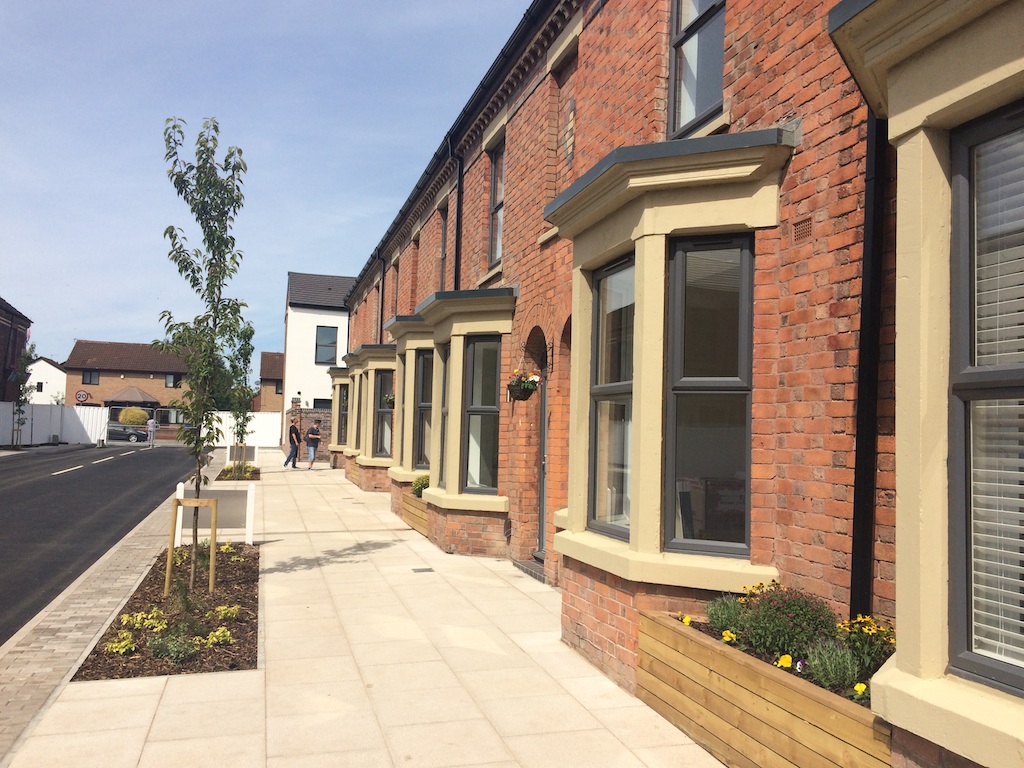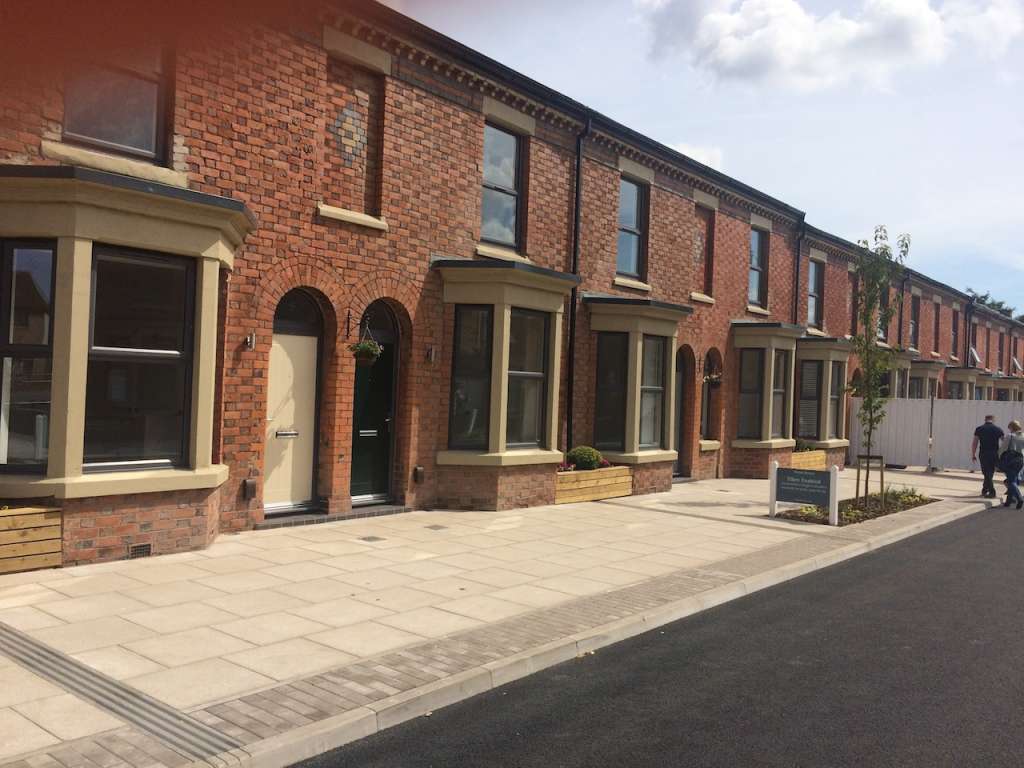Press release: The Welsh Streets: a transforming moment
23 August 2017
Press release: The Welsh Streets: a transforming moment
SAVE's prolonged battle to prevent the needless and wasteful destruction of tens of thousands of decent terraced houses in the north of England has received triumphant vindication with the opening in August 2017 of the first restored houses in Liverpool's Welsh Streets.
This has been the fiercest and most intense battle SAVE has ever had to fight, aimed at halting the infamous 2005 'Pathfinder' policy dubbed, 'bulldoze the north and concrete the south'. Up to 400,000 homes across the north of England and Midlands were targeted for demolition, 18,000 of them on Merseyside. Many terraces were demolished, but others were left derelict when the policy was abandoned as a failure in 2011, including Liverpool’s Anfield, Granby and the nearby Welsh Streets.
The restoration and revival of the Welsh Streets has been undertaken by Manchester-based house builders PlaceFirst. The first batch of newly completed houses ingeniously offers a variety of homes within the walls of the existing terraces. Four bedroom houses have been created by linking two neighbouring houses. In other cases three houses have become two - each with three bedrooms. Other houses have been restored as two and one bedroom accommodation.
Facades have been restored with careful attention to original detail and features. There are generous pavements, good paving and new street trees. The demolition of rear wings (outriggers) has brought much more light into the back of the houses.
SAVE Director Henrietta Billings says: "It’s fantastic to see these houses brought back to life - in a way that shows how versatile terraced houses can be. It smashes the myth that this type of housing was beyond its sell by date - and shows what persistent campaigning by us and many groups and individuals can achieve. The terraces have been updated and adapted, while keeping the human scale and character of the 19th-century streets and celebrating this part of Toxteth's history."
SAVE Executive President Marcus Binney says: "We have spent 13 agonising years publishing reports, fighting planning enquiries, supporting and initiating legal challenges, and watched the evictions of numerous families fighting to stay in their homes. The lost houses of Anfield, Bootle, Edge Lane and Gateshead are etched in our memories as it has now been proved they need never have been demolished and could have been refurbished at reasonable cost as much needed homes."
SAVE Liverpool representative Jonathan Brown says: “By proving once again that historic inner cities remain popular and even futuristic, and not ‘low demand and obsolete’ as claimed by devotees of demolition, the renovated Welsh Streets will stand as a shining example of creative reuse against the cult of comprehensive redevelopment and the miseries of managed decline.
“Over 13 years, such determined lobbying has had a transformational effect on the place of terraced housing in the national discourse, moving it from obsolete slum in the eyes of some, to - in the case of Granby Street - a Turner-Prize-winning treasure.”
SAVE’s long term campaign-work helped connect isolated residents across pathfinder demolition zones and build a platform on which their concerns could attract national attention.
Jonathan Brown led much of this bridge building, working to advocate street level campaigns to national policy makers, drawing legal and media firepower to their cause. Jonathan wrote many of SAVE’s numerous planning interventions, building the case for the public inquiry, which ultimately saved the homes and re-set national regeneration policy.
Public Inquiry
Despite the cancellation of the Pathfinder policy in 2011, Liverpool City Council still attempted large scale demolition of the Welsh Streets, and SAVE led the opposition to this demolition at a public inquiry in 2014. The Council alleged that the houses were beyond economic repair and should be demolished without delay. In his decision in January 2015, the Secretary of State Eric Pickles strongly supported SAVE’s case and ruled:
“Overall... the Secretary of State is not persuaded that the scale of demolition proposed in this case - has been demonstrated to be necessary and that sufficient forms of market testing and options involving more refurbishment have been exhausted… Though the proposals retain some of the existing street names and the geographical location and orientation of those streets, the Secretary of State considers that in other respects the existing character of the Welsh Streets would effectively be lost. Existing density would be halved and the Secretary of State agrees with SAVE that the proposed scheme takes a suburban approach given the space surrounding buildings and the focus on the private plot rather than the collective street.”
SAVE'S impressive team at the inquiry was led by barrister James Potts from 39 Essex Chambers, and included former planning and design officer Alec Forshaw, architect Trevor Skempton, former Director of Empty Homes charity David Ireland, structural engineer Ed Morton, local Beatles historian Dave Bedford, estate agent Paul Sutton, and architectural historian Gareth Carr. We also had support from the National Trust and Professor of Architecture at Liverpool University Dr Neil Jackson, and local Beatles historian Phil Coppell. Fiona Deaton of Maisna Heritage put together an illuminating Heritage Statement about the architectural and cultural significance of the area.
Our case also contained new evidence about the architect of the buildings, Richard Owens, the subject of a PhD thesis by our witness Gareth Carr. His research established that the houses were 20 years older than was originally thought and were part of a larger estate by Owens, for Welsh builders and craftsmen brought into construct many of Liverpool's most famous Victorian buildings. Most of the streets were given Welsh names. Carr argued that the Welsh Streets and Owen are pivotal to the understanding and the development of the terraced house nationally and even internationally, not just in Liverpool.
SAVE sought out ex-Welsh Streets residents who had been displaced by the demolition scheme and moved away, ensuring voices were heard that would otherwise have been overlooked, voices such as those of Mrs Magda Maylam, who spoke at the public inquiry, and Carmen Muberry, who had lived in Madryn Street since 1947. Our evidence base also helped counter claims by the council that the homes were in poor repair to start with, showing they were in fact better than the city average before demolition was imposed, with fewer empty. Our FOI requests also proved there had been no proper surveys done of housing condition or repair costs, and demonstrated that over £20m of spending had been written off.
A significant impact of SAVE’s campaign in Liverpool has been the scrapping of a raft of government regeneration guidance that facilitated the long-term blight of housing areas in advance of their eventual demolition. Liverpool council has cited this policy change as key to their reluctant decision to drop their legal challenge and accept renovation as the way forward.
Read more about the public inquiry and the Secretary of State’s decision here in our 2015 report.
Copies of SAVE's 2006 report on Pathfinder are available here.
Madryn Street
SAVE was instrumental in stopping the pre-emptive demolition of the Welsh Street houses when it bought the last occupied house in Madryn Street in 2011, and refurbished it and let it to a local couple. The house was a few doors along from Ringo Star's birthplace, and was the home of Ringo Star's aunt. He spent much of his childhood in Madryn Street both with his aunt and his grandmother who lived at the far end of the street.
SAVE is indebted to the groups and individuals who donated money to the public inquiry campaign, and who gave us their talents, materials and time to refurbish our house in Madyrn Street.
Notes to Editors:
1. For more information please contact SAVE on 0207 253 3500 or office@savebritainsheritage.org
2. SAVE Britain’s Heritage has been campaigning for historic buildings since its formation in 1975 by a group of architectural historians, writers, journalists and planners. It is a strong, independent voice in conservation, free to respond rapidly to emergencies and to speak out loud for the historic built environment.Press release issued by SAVE Britain’s Heritage




